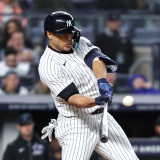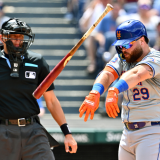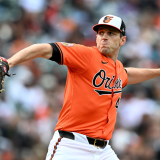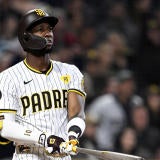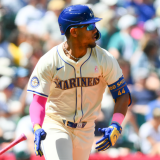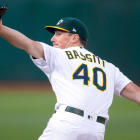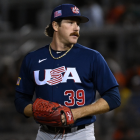Every year several players have their roles changed at midseason, and immediate success follows. Drew Pomeranz was last year's big success story. He was not very good as a starter early in the year, but, following a move into the bullpen and a dominant finish, Pomeranz scored a four-year contract worth $34 million as a free agent. Role changes don't get much more successful than that.
Last week we examined three hitters who had big power surges late in the season. This week we're going to look at three pitchers who changed roles at some point last year, and how that changes their outlook moving forward. The starter-to-reliever role change is a common one (the most common one, really), though at least one notable pitcher went from reliever to starter.
Chris Bassitt is one of the better kept secrets in baseball. The 31-year-old joined the Athletics in the Jeff Samardzija trade with Marcus Semien way back when. He had Tommy John surgery in May 2016, and it wasn't until last season that he was completely healthy and a full participant without restrictions in spring training. He threw 144 innings with a 113 ERA+ in 2019.
Bassitt made 25 starts before moving into the bullpen in September not because he pitched poorly, but because the A's were deep in arms. The club added Homer Bailey and Tanner Roark at the trade deadline, Sean Manaea returned from shoulder surgery in early September, and Frankie Montas returned from his performance-enhancing drug suspension in late September.
Oakland had more starters than rotation spots late in the season and Bassitt was the odd man out. He made three relief appearances in late September, firing five scoreless innings and striking out nine.
| Date | IP | H | R | BB | K |
|---|---|---|---|---|---|
Sept. 20 vs. TEX | 1 | 0 | 0 | 0 | 2 |
Sept. 22 vs. TEX | 3 | 1 | 0 | 0 | 5 |
Sept. 29 vs. SEA | 1 | 0 | 0 | 2 | 2 |
Total as reliever | 5 | 1 | 0 | 2 | 9 |
Five innings doesn't tell us a whole lot, especially when they came against two teams out of the postseason race. And, truth be told, there was no real change in Bassitt's stuff out of the bullpen. Some guys shift into a relief role and add velocity because they can cut it loose for an inning or two rather than pace themselves through five or six innings. Bassitt's velocity didn't spike or anything.
What did change was his mental approach. Like many pitchers, Bassitt saw the bullpen as something of a demotion earlier in his career. He was a starting pitcher and a move into a relief role was a threat to his livelihood. Now that versatile swingman who can start or relieve is very valuable. That guy is a key member of the pitching staff these days.
"I think a couple years ago, I saw this role and I saw it as a threat to myself. Them saying, 'We don't really trust you in either role.' Now I think of it as the complete opposite. I think it's them saying, 'We trust you to do both," Bassitt told Shayna Rubin of the Bay Area News Group in September. "... I knew I could throw out of the bullpen and be good. Why make anyone else uncomfortable."
A.J. Puk's spring shoulder issue meant Bassitt was likely to open the season in the rotation prior to the shutdown. Ideally though, the A's would use him as a Swiss Army Reliever. Someone who can throw two high-leverage innings late in a close game or make a spot start when there's a need in the rotation. It's not an easy job and it requires buy-in. Bassitt has bought in now and he's made himself that much more valuable to the A's.
"It's easier to not care when your team is positioned to be really good," Bassitt told Rubin. "I think every person in this room has one goal in mind and that's to win the World Series. I know 30 teams are saying that, but there's not 30 teams that have a chance to do that, and I think we have a true chance to do that. It makes the idea of doing either one a heck of a lot easier when you know you're going to be really special this year, or have a chance to be."
Usually when a pitcher changes his role and finds success, he shifts from the rotation to the bullpen. It's not often guys go the other way and have immediate success. C.J. Wilson did it back in the day and more recently Mike Minor successfully transitioned back into a starter after a dominant stint in the bullpen. It doesn't happen often, but Mike Montgomery pulled it off last season.
Montgomery, who opened the year in his usual swingman role with the Cubs, was traded to the Royals at the deadline and Kansas City immediately plugged the 30-year-old in its rotation. From 2016-19, Montgomery made 38 starts and 81 relief appearances with the Cubs, and now the Royals were giving him a chance to start with no strings attached. No looking over his shoulder.
"I've wanted to start, but the opportunities weren't there in Chicago," Montgomery told Todd Fertig of the Capital-Journal last August. "You don't have a lot of control over things in this game, but when I heard (I would be sent) here, I was super excited. I got drafted by these guys, and they told me when they made the trade, 'We want you as a starter, and that's what we want you to be successful at.' I'm thankful for the opportunity here and I'm just trying to make the most of it."
| IP | ERA | WHIP | BB% | K% | GB% | HR/9 | |
|---|---|---|---|---|---|---|---|
Reliever with Cubs | 27 | 5.67 | 1.78 | 10.6 | 14.6 | 43.3 | 2.00 |
Starter with Royals | 64 | 4.64 | 1.55 | 7.5 | 18.3 | 51.5 | 1.69 |
The overall numbers with Kansas City are not great but some early clunkers skew the results. In his first three starts with the Royals, when he was still stretching out his pitch count, Montgomery allowed 10 runs in 11 1/3 innings. He made 10 starts after that and pitched to a 3.93 ERA in 52 2/3 innings. Montgomery allowed no more than two earned runs in seven of those 10 starts. That's more like it.
Montgomery came up through the minors as a starting pitcher and he's always had a starter's repertoire. As a swingman with the Cubs, he focused mainly on his sinker and curveball because those are his best pitches, and guys usually condense their arsenals when working out of the bullpen. Once he got to the Royals, Montgomery threw all five pitches regularly.
Check out Montgomery's pitch usage by game last season. It is very easy to see when he arrived in Kansas City, diversified his arsenal, and began working as a starting pitcher:
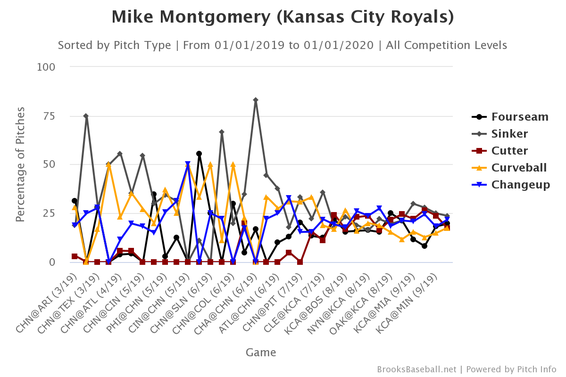
Montgomery went from throwing mostly sinkers and curveballs (and a few changeups) with the Cubs to throwing five pitches at least 15 percent of the time with the Royals. The sinker and the changeup are above-average ground ball pitches, the curveball misses bats at a better-than-league-average rate, and the four-seamer and cutter give hitters something else to worry about.
By no means is Montgomery a budding ace or anything like that. He'll turn 31 in July and consistently throwing strikes has always been a challenge, but it's a workable arsenal, and now he has a set role and a set routine. For a rebuilding team like the Royals, picking up a league average-ish starter with another two years of team control is a nifty little move. It's not all about hoarding stars. Incremental upgrades like Montgomery help bring a team that much closer to contention.
"I didn't ever get settled into that consistent routine. Without that consistent schedule, it's tough," Montgomery told Fertig. "... So I'm glad to just get into one set role and see what I can do. I've started enough in my career to really understand that routine. I think now I know what it takes to be successful at that role. So that's where I'm at now."
You are forgiven if you look at Matt Strahm and confuse him for Josh Hader. The two lefties have similar deliveries and similar hair and, frankly, sometimes that's all it takes to confuse two pitchers. Strahm is not quite as dominant as Hader (few are) but he is very good in his own right. Last season he struck out 37 batters in 33 relief innings. Here's a Hader-esque strikeout:
The Padres tried Strahm in the rotation early last season and, for a while, the experiment was working well. He had a 3.06 ERA in his first nine starts, and in eight of those nine starts he allowed two runs or less. The wheels came off after that though. Strahm allowed 31 runs in 29 2/3 innings in his next six starts. Suddenly he had a 5.42 ERA through 15 starts. That's not so good.
San Diego moved Strahm back into the bullpen in early July -- he spent just about the entire 2018 season in relief -- and he was very good the rest of the season. Not only did the results improve, but so did the quality of his stuff:
| Strahm as a starter | Strahm as a reliever | MLB average | |
|---|---|---|---|
Fastball velocity | 90.8 mph | 93.0 mph | 93.4 mph |
Fastball swing-and-miss rate | 20.4% | 21.7% | 21.8% |
Slider velocity | 85.5 mph | 87.2 mph | 84.7 mph |
Slider swing-and-miss rate | 25.4% | 32.6% | 35.8% |
Strahm was working with comfortably below-average fastball velocity and a well-below-average slider swing-and-miss rate as a starter. He was a soft-tosser, basically. In relief, everything moved closer to average, and while average is not the most exciting thing in the world, it's a lot better than where Strahm was as a starter. It helps that he has a deceptive delivery that is all arms and legs. He hides the ball well and everything plays up.
Some pitchers are just built for the bullpen. Wade Davis was a completely different animal in relief than he was as a starter. Zack Britton too. He went from middling starter to lights-out reliever. Strahm seems cut from a similar cloth. He didn't wow anyone or overpower hitters as a starter. He was just another guy. In relief though, he forces you to pay attention. It should be noted Strahm still envisions himself as a starting pitcher.
"I'm still a starter," Strahm told Kevin Acee of the San Diego Union-Tribune in July. "I know I am. I totally understand where the organization is at right now with the amount of young arms they have, what they need to see, what they need to know they can do for the future. But I feel like I've already proven to them that I have a unique set of skills, and I hope that no one's judging me on my last five and that it's 15 as a whole that I'm getting judged off."
On one hand, it's good Strahm has a chip on his shoulder and wants to show everyone he can start. You want motivated players. On the other hand, everything points to him having a future in the bullpen. He's been far more effective in that role throughout his career and, with his 29th birthday coming up later this year, it's time to carve out a set big-league role. You don't want to enter your age-29 season still trying to show folks what you can do.
"I go, 'OK, when do I set my pride aside and do what's best for the team?'" Strahm told Acee. "... The one thing that matters to me is winning. It doesn't matter to me from a selfish standpoint what I'm doing for my career. I'm more focused on this season, on what this team can do and what we're capable of. If that means being in the bullpen to help us out there, you're not going to see me put up a fuss about going there."
The Padres were planning to keep Strahm in the bullpen this season and that's where he fits best. Once he fully embraces the role like Bassitt did last year, he could find another level to his game, and become a truly dominant reliever. For the Padres, a rebuilding team looking to make the jump to contender, giving Strahm a chance to start last season made sense. It didn't work though, and now it's time to use him where he's most effective, and that's in the bullpen.













